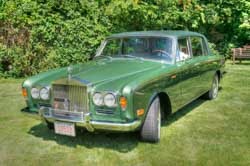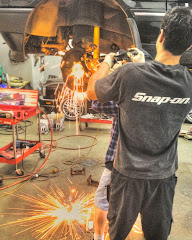Automobiles of today are far less maintenance-intensive than those of a generation ago. Fluids, filters, and spark plugs all last
longer. Cars once required service
every three months or 3,000 miles. Now
the most basic service – an oil change – has moved to a 12-15 month or 7,500-15,000
mile interval.
Dealers and quick lube centers market oil changes as commodity
services that can be performed quickly while people wait. The basic service consists of draining and
refilling oil, changing the filter, checking the under hood fluids, setting
tire pressures, resetting the oil service reminder and looking for warning
lights or obvious problems.
In theory, a trouble-free car might only visit a service department once a year.
That left us uncomfortable with the basic service the dealers and quick
lubes were touting, and it led us to a philosophy we adopted about ten years
ago.
If we were only going to see a car once a year, we reasoned,
it made sense to have a skilled technician do the service. Our idea was that a skilled tech would
be more likely to spot incipient issues than a less highly qualified lube
person. We felt that it made sense to
allow the tech an extra half an hour to look the car over. We left it to the tech to decide what any
particular car needed – maybe it was pulling a wheel to look at a brake caliper
that might be dragging, or perhaps it was running a system scan with the
diagnostic tool to look for hidden electronic issues. Our thought was to budget enough time for a
careful inspection.
Those comprehensive examinations often revealed problems
owners hadn’t known about, like water pumps that were starting to leak or electronic
codes that warned of impending module failures.
For the most part, the enthusiast clients we served appreciated the
extra attention we gave their cars.
The only problem with such a service philosophy proved to be
cost. Labor rates in most shops rose
significantly in the past 10-15 years.
In most of the country, shop rates for high-end cars now range from
$120-180 per hour. At the same time,
cars got more complex and it takes more time to do these more comprehensive
inspections. An extra half or three
quarters of an hour added $75-120 to the bill, a noticeable amount for many. Meanwhile, charges for basic oil service at many dealers
held steady, or went down. By packaging the inspection with the oil change, we were selling a different and more expensive service, but to a potential client on the phone, it seemed the same.
Labor was not the only area of concern, when it came to cost. Carmakers like BMW and Mercedes brought out private label
oils priced lower than more broadly compatible synthetics like Mobil 1. Mercedes (for example) began recommending changing oil with
a siphon system to avoid lifting the car, and they moved the filter under the
hood in support of that. Dealers of all
makes were encouraged to build quick lube bays in the manner of Jiffy
Lube. Those measures and manufacturer
pressure has kept basic oil change prices down in many areas.
That put independent shops like ours in an unusual
position. With the addition of a comprehensive look over, our oil changes were significantly more expensive than oil changes at the dealership. Independent garages are widely perceived as
less expensive alternatives to the dealer, and with this move, that notion was
turned on its head.
Through my writing on the car business I have gotten to know
many dealer service managers, as well as factory service reps and independent
service professionals. From our
conversations a new oil change and inspection philosophy has emerged.
Most new cars start out being serviced at the dealer. When the warranty expires owners often shop
around for alternatives. That is the
moment when the quoted oil change price may keep a motorist with the dealer or send
them elsewhere. Often those
relationships initially turn on a phone call.
A dealer client has less incentive to try alternatives if alternative
providers quote a higher price for what the motorist feels is a basic service.
For someone who calls with the idea of comparing our service department to the one at the dealer, the fact that our oil service includes a thorough check is often irrelevant, because it's not understood. The caller was seeking to make a comparison, and if our number is bigger, we seem more expensive and that may end the exploratory call then and there.
Years ago, I felt shops compromised quality by doing quick,
low cost services. Now we see an
alternative. We treat oil changes as
quick, inexpensive, commodity work that is limited in scope to what the words
say. Where we once thought the oil
change was likely to be the car’s once-yearly visit to our shop, we now realize
that most older cars will be back at least once for resolution of a
problem. Perhaps a warning lamp has come
on, or the engine is leaking coolant. When the car comes in for those issues, we ask
if they’d like us to look it over for other problems or concerns. 99% of the time, the answer will be yes.
We have shifted the time we spend inspecting cars for
incipient problems from the oil change visit (a quick commodity service) to the
repair visit (a more open ended and less commoditized visit.)
Given that most cars will have at least one of each kind of
visit in a year clients still receive the same annual inspections, the price of
the commoditized oil change remains low, and the overall service cost remains
about the same. The same value is
provided, the only change being some things come at a different time.
For those who ask, we will do a comprehensive
inspection at any time but on the bill we keep it separate from the oil change. We've learned to distinguish this basic service from the "small service" which combines oil change and inspection, and we've also learned to tell customers when the car or mileage calls for more than just an oil change. Our advisor makes this point to clients before work is done. Sometimes clients want "just an oil change" but other times, they wanted the complete mile-appropriate service but did not know how to ask for it.
In that case, we do what's appropriate. That's also what we do when someone says "change the oil and look the car over for the season." Before beginning, we explain what we will be checking, and roughly how long it will take and how much that will cost. Time varies by car and condition, and we've careful to explain that this is "much more than just an oil change," the basic unit we build upon.
On a modern car that is driven daily an oil change and thorough check over might take 1-2 hours in total. On a collector car the time needed for though inspection will be longer, and older cars usually have more points for lubrication. Older cars are also more likely to have adjustment needs where those jobs are done by computer on newer models.
The tasks of auto service continue to change and evolve, but at some level the oil change remains the same. It will probably continue to be the basic unit of car service until electric cars render that task obsolete, except on collector cars, aged cars, and commercial vehicles. I will probably be retired when that happens but the next generation will confront a new set of challenges as maintenance of transport machinery never goes away; it just evolves.
In that case, we do what's appropriate. That's also what we do when someone says "change the oil and look the car over for the season." Before beginning, we explain what we will be checking, and roughly how long it will take and how much that will cost. Time varies by car and condition, and we've careful to explain that this is "much more than just an oil change," the basic unit we build upon.
On a modern car that is driven daily an oil change and thorough check over might take 1-2 hours in total. On a collector car the time needed for though inspection will be longer, and older cars usually have more points for lubrication. Older cars are also more likely to have adjustment needs where those jobs are done by computer on newer models.
The tasks of auto service continue to change and evolve, but at some level the oil change remains the same. It will probably continue to be the basic unit of car service until electric cars render that task obsolete, except on collector cars, aged cars, and commercial vehicles. I will probably be retired when that happens but the next generation will confront a new set of challenges as maintenance of transport machinery never goes away; it just evolves.
To some this may seem like sizzle, as opposed to steak. That may be, but in many situations, sizzle
is the basis for choice. Our goal is to
provide the best service at fair prices and to do that, we must start by bringing
new clients through the door. That is
going to be harder if we start at a perceived price disadvantage, whatever the
reality may be.
When dealing with a car that provides day to day transportation I believe it's cheaper to head off a breakdown with preventative maintenance. I'd rather have my car looked over for potential problems by someone I can trust to be competent and truthful. I'm happy to pay the extra time a look-over takes. Other people don't share that particular point of view, and they want their oil changed and nothing more. For them, a basic no frills oil change is the ticket, and when their car breaks down, we can offer an inspection.
When dealing with a car that provides day to day transportation I believe it's cheaper to head off a breakdown with preventative maintenance. I'd rather have my car looked over for potential problems by someone I can trust to be competent and truthful. I'm happy to pay the extra time a look-over takes. Other people don't share that particular point of view, and they want their oil changed and nothing more. For them, a basic no frills oil change is the ticket, and when their car breaks down, we can offer an inspection.
© 2017 John Elder Robison
John Elder Robison is the general manager of J E Robison Service Company, celebrating 30 years of independent Bentley, Rolls-Royce, BMW/MINI, Mercedes, and Land Rover restoration and repair in Springfield, Massachusetts. John is a longtime technical consultant to the car clubs, and he’s owned and restored many fine British and German motorcars. Find him online at www.robisonservice.com or in the real world at 413-785-1665
Reading this article will make you smarter, especially when it comes to car stuff. So it's good for you. But don't take that too far - printing and eating it will probably make you sick.



























No comments:
Post a Comment